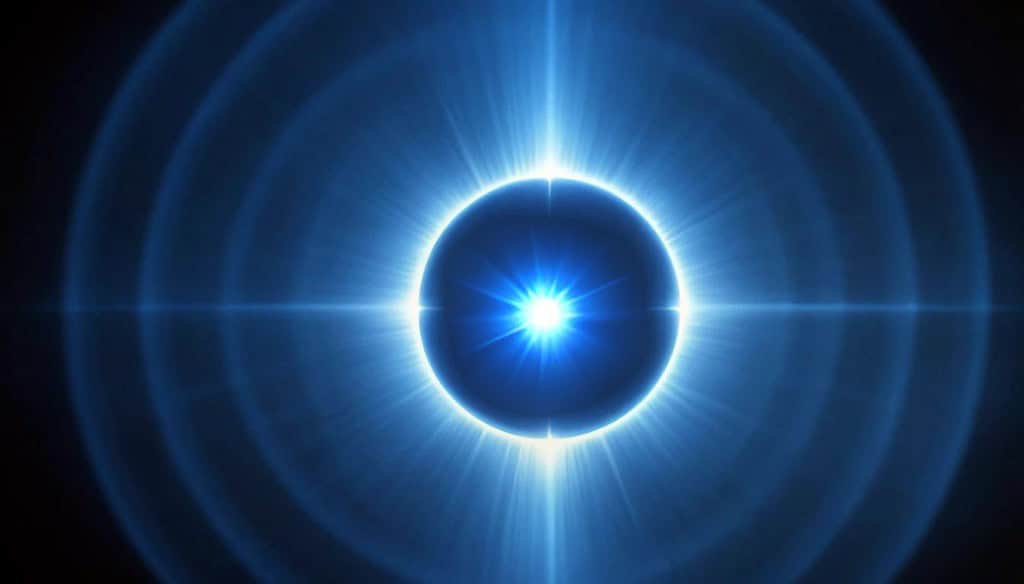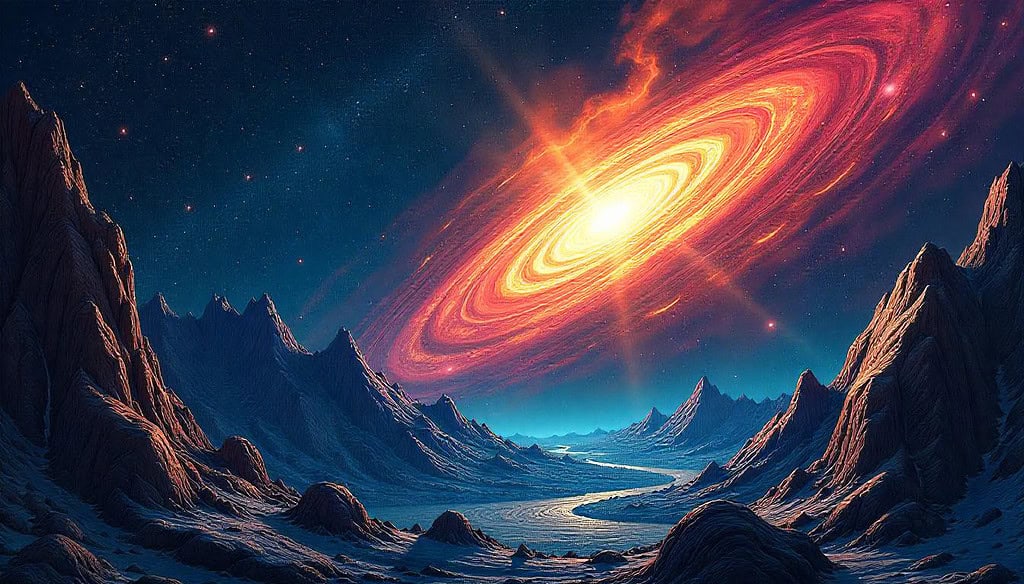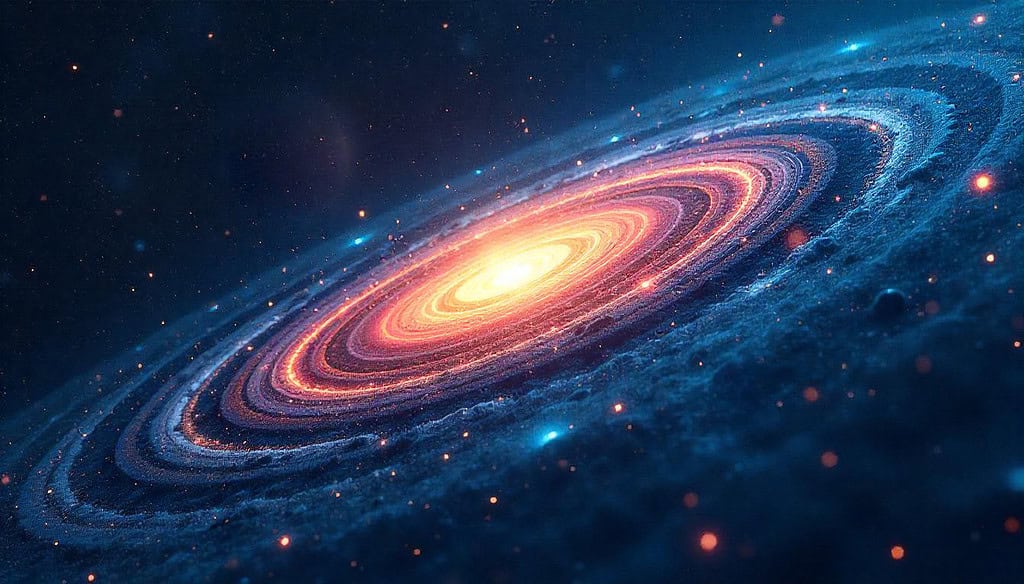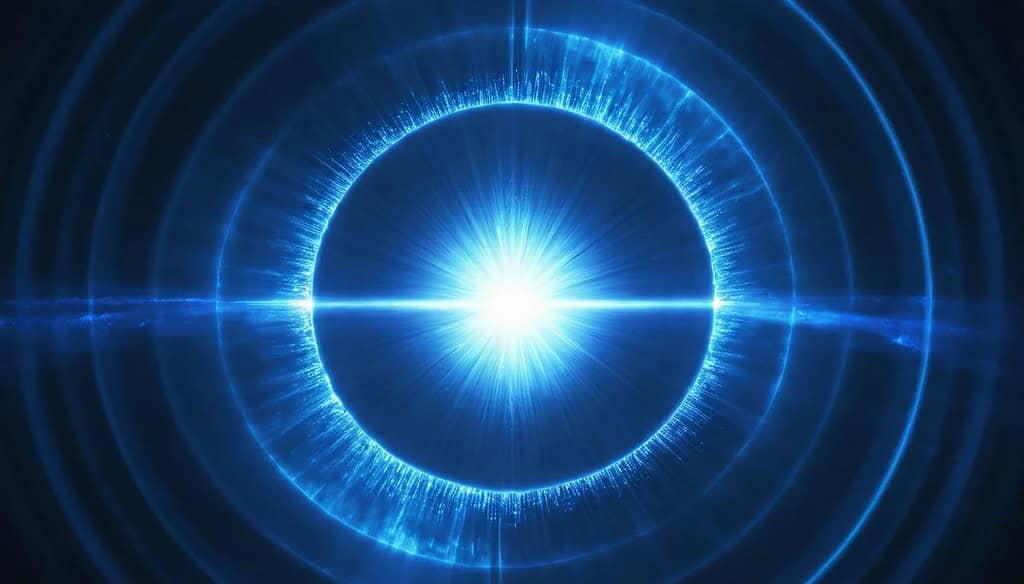Table of Contents
Big Bang: In the Beginning, There Was a Spark

Big Bang — In the Beginning, There Was a Spark
The universe we know, with its stars, galaxies, and endless stretches of space, began from a moment so unfathomably small that it could fit within the space of a single point. This moment, often referred to as the Big Bang, wasn’t an explosion in the traditional sense. Instead, it was the birth of everything we understand about time, space, and matter. It’s hard to imagine how something so vast and intricate came from such a small beginning, but it did—like a spark that ignited a flame, or perhaps more accurately, like a match that set the cosmos alight.
In that first instant, all the matter and energy that would eventually become the stars, planets, and even life itself, were packed into an infinitesimally tiny point—dense and hot beyond our comprehension. There was no space or time as we know it, and the universe as a whole was a swirling, glowing mass of potential. The Big Bang was not a singular explosion but rather an event in which space itself began to expand, carrying with it everything we would later see in the sky.
I often think of that first spark as the most important moment in history, not just for the universe, but for the stories we tell ourselves about existence. It’s the point from which everything, every second, every atom, traces its lineage. The Big Bang didn’t just create the universe—it set in motion the conditions for everything to unfold, like a melody that begins with a single note and gradually transforms into something much more complex.
As the universe expanded, cooling from its initial fiery birth, the first atoms began to form, and with them, the elements that would one day come together to create stars. These stars would then give birth to galaxies, systems of planets, and eventually, life as we know it. The Big Bang wasn’t just an event; it was a chain reaction that continues to echo in the cosmos.
It’s hard not to marvel at the beauty of this cosmic narrative. From a single spark, the universe was born—vast, infinite, and teeming with possibility. When we look up at the stars, we’re not just gazing at distant points of light; we’re connecting to that first moment, the Big Bang, when everything began. The spark that ignited the universe’s journey continues to shine brightly in the night sky, reminding us that we, too, are part of something far greater than ourselves.
Big Bang: Stirring the Cosmic Cauldron

Big Bang — Stirring the Cosmic Cauldron
1. The Recipe for the Universe
Imagine you’re about to bake a cake. You need the ingredients: flour, sugar, eggs, and milk. Without these basic ingredients, the cake wouldn’t exist. Now, let’s think about the universe in a similar way. At the moment of the Big Bang, everything that we know—space, time, matter, energy—came from a singular point. It was a cosmic version of gathering the essential ingredients for something much bigger, more complex, and more profound than we can easily grasp.
Before the Big Bang, there was no space, no time, and no matter—just potential. The universe, as we know it, came into being from this incredibly tiny, dense point where everything was compressed into a fraction of the size of a single atom. It’s hard to even picture, but we can think of it like a balloon that hasn’t been inflated yet—everything is packed into a tiny space, but with a simple flick of the wrist, the universe began to expand.
Just like any recipe, the universe needed a specific set of elements to kickstart its existence. But what were these ingredients? In a way, they were all the forces that govern the cosmos today—gravity, electromagnetism, and the strong and weak nuclear forces. All of these forces had to be in perfect balance for the Big Bang to occur and for the universe to begin unfolding in the way we understand it today. Without the right “ingredients,” there would have been no universe, no stars, no galaxies—just a void.
As the universe began to expand and cool, these ingredients came together to form the first particles of matter. These particles would eventually come together to form the atoms, stars, and planets that make up the universe we know. So, in the same way that a cake needs flour, eggs, and sugar, the universe needs its ingredients to start this incredible journey.
2. A Pinch of Forces
Have you ever tried making a dish and thought, “Hmm, it could use just a pinch more salt”? When making something special, the right amount of each ingredient is crucial to getting the perfect flavor. Well, the universe’s formation is similar. The forces that govern the universe, like gravity, electromagnetism, and nuclear forces, played an essential role in shaping everything after the Big Bang.
At the moment of the Big Bang, these forces were in a delicate balance. If one force had been slightly stronger or weaker, the entire course of the universe’s history would have been different. Imagine baking a cake and not having the right balance of flour and sugar—it could collapse, or just taste bad. Similarly, the universe could have collapsed into nothing or expanded too quickly without these forces in perfect proportion.
Consider gravity as an illustration. Gravity is the force that attracts objects to one another. In the absence of gravity, stars would not have been created, and galaxies would not have coalesced. It serves as the adhesive that maintains the structure of the universe. Additionally, electromagnetism plays a crucial role in binding atoms together. Without this force, matter would not assemble into the solid entities we observe in our surroundings. Lastly, the strong and weak nuclear forces govern the interactions within atoms, which are the fundamental components of all matter in existence.
These forces, much like the right seasonings in a meal, are what gave the universe its structure. The Big Bang was just the start, but the real “cooking” happened as these forces began to take effect. Without them, we wouldn’t have the universe we see today.
3. Stirring the Cosmic Pot
Envision yourself mixing a pot of soup that is simmering on the gas stove. As you stir, the ingredients mix and interact, and over time, the soup comes to life. The same is true for the universe after the Big Bang. After the initial moment of creation, everything began to expand and cool. But this wasn’t a calm and simple process. It was like stirring a cosmic pot, with particles, energy, and forces all interacting in a chaotic, yet purposeful, way.
At first, the universe was incredibly hot and dense, with all sorts of particles zipping around at incredible speeds. As it expanded, it cooled down, allowing for the formation of atoms, the basic building blocks of matter. This is like adding ingredients to your soup one by one, letting them blend together over time. These ingredients didn’t form anything complex immediately—they had to go through several stages of mixing and cooling to eventually form something recognizable.
As the universe cooled, the first atoms—mostly hydrogen and helium—began to form. These were the simplest of elements, but they set the stage for everything else. Just like how soup starts out with a few simple ingredients, the universe started with just a few basic elements and everything that came later was built off that.
The cosmic stirring continued as gravity began to take over. It started pulling atoms and particles together to form the first stars. These stars were the first “cooked” ingredients in the universe, born from the chaotic blending of particles and energy. It wasn’t a quick process, but it was the key step that would eventually lead to the formation of galaxies and planets.
4. Inflation: The Pressure Cooker Effect
Picture this: You’re cooking something in a pressure cooker, and as it heats up, everything inside it starts expanding rapidly. It’s a bit like what happened during the very early moments of the Big Bang. The universe, which started out as a tiny point, underwent a process known as “inflation” – a rapid, mind-boggling expansion. It’s like taking that tiny point and suddenly blowing it up into something far larger than we can even fathom.
This rapid expansion didn’t last long, but it was crucial. Within a fraction of a second, the universe expanded by an enormous factor, stretching from something incredibly small to the size of a melon. This is like turning the heat up in a pressure cooker and watching everything inside quickly expand. Inflation helped to smooth out the universe, ironing out any wrinkles and making it more uniform.
Before inflation, the universe was too small to form the patterns we now see. But after inflation, everything became more evenly distributed. It’s like stirring your soup and suddenly realizing that all the ingredients are now evenly spread throughout. Inflation set the stage for the formation of galaxies, stars, and all the structures we see in the universe today.
Without inflation, we wouldn’t have the large-scale structures we see today. It was a critical phase in the evolution of the universe, and without it, the universe would have looked completely different.
5. Cooling the Cosmic Soup
As the universe continued to expand, it began to cool down—just like letting a hot bowl of soup cool off after you’ve finished cooking. In those first few minutes after the Big Bang, the universe was still incredibly hot. However, as time passed, it started to cool, and the energy that had been released during the Big Bang began to condense into matter.
This cooling process allowed the particles that had been flying around at high speeds to slow down and come together. Just like how the ingredients in soup settle and become more distinct as it cools, the cooling universe allowed particles to form more stable structures. It was during this cooling phase that atoms—mostly hydrogen—formed, marking the beginning of the universe’s matter.
Think about boiling water, where bubbles start forming at the surface before the water cools. In the same way, as the universe cooled, atoms began to form, and they eventually came together to create stars. This cooling process was a necessary step in the formation of the elements that would eventually become planets, galaxies, and all the other structures in the cosmos.
Without this cooling phase, the universe would have remained a chaotic, hot soup of energy, unable to form anything more complex. It was through this cooling process that the building blocks of the universe were able to settle into place, creating the foundation for everything that followed.
6. From Ingredients to Structure
Now that the universe had cooled and atoms had formed, it was time for everything to come together. Just like how ingredients come together to form a dish, the atoms in the universe started to combine, creating more complex structures. This is when the first stars began to form.
These stars were the first big “ingredients” in the cosmic recipe. The matter that had been formed from the Big Bang—mostly hydrogen—was now coming together under the influence of gravity. Think of it like dough rising in the oven. As gravity pulled atoms together, stars started to ignite, and the first light was born.
The universe, once just a soup of particles, began to form its first recognizable structures. These stars weren’t just the light sources of the universe—they were the factories where heavier elements like carbon and oxygen were created. These elements would later become the building blocks for planets, life, and everything else.
This step is like the moment when your soup becomes a stew—hearty and filled with flavor. The universe was starting to form more complex structures, setting the stage for the creation of galaxies, solar systems, and eventually, planets like Earth.
7. The Lingering Aroma: Cosmic Microwave Background
Have you ever noticed that after cooking a delicious meal, the smell lingers in the kitchen long after the meal is over? The Big Bang left a similar lingering trace—the Cosmic Microwave Background (CMB). This faint glow, detectable even today, is the leftover “smell” from the early universe, a remnant of the heat from the Big Bang that still permeates space.
The Cosmic Microwave Background (CMB) can be likened to the scent of a meal prepared in the distant past. Despite the universe’s expansion and cooling over time, this subtle radiation remains observable through advanced instruments. It serves as a glimpse into the universe’s state when it was merely 380,000 years old, a period during which atoms had recently formed and the universe had cooled sufficiently to allow light to move unobstructed through space.
In a way, this lingering radiation is a reminder of the Big Bang. Even though the universe has evolved and changed dramatically since that moment, the faint glow of the CMB still carries the memory of the birth of everything we see today. Just like how the aroma of a dish tells you a story about what happened in the kitchen, the CMB tells the story of the universe’s earliest moments.
8. The Ongoing Cosmic Dance
The Big Bang was just the beginning, but it set the stage for a dance that’s still going on today. Imagine a ballroom filled with dancers moving gracefully, each one playing its part in a never-ending cosmic performance. This dance started right after the Big Bang and continues to unfold. As the universe expanded and cooled, galaxies formed, stars were born, and planets began to take shape. The movements of the universe have never stopped—they just keep evolving.
Today, we can see the evidence of this ongoing dance that started with the Big Bang. Galaxies continue to move apart, stars are born and die, and the universe continues to expand. This expansion, which began with the Big Bang, is still happening. It’s as if the music never stops, and the dancers never rest. The universe is still in motion, creating new stars, new galaxies, and new mysteries that continue to unfold.
The Big Bang may have been the first step, but it was only the beginning of a cosmic ballet that’s been in motion ever since. The universe’s dance will continue for billions of years, creating new wonders and shaping the cosmos in ways we can only begin to imagine. Just as every great dance performance has a beginning, a middle, and an ongoing rhythm, so too does the universe. The Big Bang was only the first note played in the symphony of existence, and the music is far from over.
Big Bang: The Universe’s Symphony in Motion

Big Bang — The Universe’s Symphony in Motion
The universe, to me, feels like a grand symphony. Imagine a vast orchestra where every instrument, no matter how small or large, contributes to a cosmic melody that has been playing for billions of years. It all began with the Big Bang—the explosive opening note that set everything in motion. From that moment on, the universe didn’t simply sit still; it became a masterpiece of rhythm and flow, a dance of celestial bodies and forces that continue to unfold.
Think of the galaxies as musical ensembles, each with its own tempo and tone. Some, like spirals, spin gracefully, much like waltzing couples on a dance floor. Others, irregular and chaotic, resemble jazz improvisations—unpredictable but still captivating. Our Milky Way is one of these performers, carrying billions of stars, planets, and mysteries in its arms, all revolving around a central black hole. This movement isn’t random; it’s like the universe has its own sheet music, guiding every star, planet, and particle in perfect harmony.
Even on Earth, we’re part of this cosmic symphony. The pull of the moon orchestrates the tides, while the Earth itself spins, giving us day and night. These motions are so natural to us that we often forget they’re part of a much larger story, one that began with the Big Bang. Just as a single violin might seem insignificant on its own but adds depth to a symphony, our planet’s small place in the universe doesn’t diminish its importance in this grand composition.
What amazes me most is that this symphony, which started with the Big Bang, isn’t static. It evolves. Stars are born, burn brightly, and eventually fade away, much like a soloist stepping into the spotlight before gracefully bowing out. Galaxies collide and merge, creating entirely new tunes in the cosmic repertoire. Even the space between galaxies isn’t silent; it expands like the pauses between musical phrases, setting the stage for what comes next.
The Big Bang may have been the opening crescendo, but the universe’s music has never stopped. We’re living in the midst of this performance, our lives unfolding in sync with its rhythms. To me, this is more than just science—it’s poetry, a constant reminder that we’re part of something vast, mysterious, and beautifully orchestrated.
Big Bang: Echoes of Perpetuity

Big Bang — Echoes of Perpetuity
Have you ever stood in a canyon and yelled, waiting for your voice to bounce back? That echo, fading into the distance, is a fleeting reminder that sound doesn’t just disappear—it lingers. The universe, in its vastness, carries a similar echo, but instead of a shout, it holds the faint whispers of the Big Bang. These are not sounds we can hear with our ears but traces of energy and light that stretch across time, connecting the past with the present.
Imagine an old photo album—each picture a snapshot of a memory. The light we see in the night sky is a cosmic photo album, with stars and galaxies as images from a time long gone. Some of the stars twinkling above us might have burned out millions of years ago, yet their light is only now reaching Earth. It’s as though the universe has found a way to preserve its history, allowing us to gaze into the past every time we look up.
One of the most remarkable echoes of the Big Bang is the cosmic microwave background radiation which we have already discussed in an earlier section. Arno Allan Penzias and Robert Woodrow Wilson discovered it accidentally and were awarded the Nobel Prize for this discovery. For this discovery, Piegions had to make a great ‘sacrifice’ as they were evicted from the radio telescope which both the scientists were using for their work.
If you’ve ever tuned a radio to an empty station and heard that faint static, you’ve stumbled upon a tiny piece of it. That is CMB and Scientists termed it a ‘remnant’ of the universe’s earliest days, a faint glow left over from the Big Bang. To me, it’s like finding an old handwritten note from someone you’ll never meet but whose words still resonate deeply.
Even on Earth, echoes of eternity surround us. The atoms in our bodies were forged in ancient stars that exploded long before our solar system existed. Every breath we take connects us to a lineage of life that has persisted for billions of years. It’s humbling to think that the water we drink might once have been part of a prehistoric river or even a comet that delivered it to this planet.
The Big Bang was not just the start of the universe; it was the beginning of a story that continues to unfold, carried forward in these echoes. Each whisper from the past reminds us that while our lives are fleeting, we are part of something enduring, a timeless symphony where every note, no matter how faint, adds to the eternal song.
Disclaimers: *This article is only for informational purposes.
**Do not make your important decisions solely based on the information provided in this article. Do your own research.
****Information in this article may vary or get updated in the future.
Read More Science and Space Articles
- 8 Amazing Lime Tales: Ancient Groves to Modern Kitchens
- 8 Weird Ways Grapefruit Can Interfere with Medications
- Pomelo in Culture: 8 Heartwarming Ritual Traditions
- 8 Culinary Uses of Oranges That I Highly Recommend
- 8 Astounding Ways Lemons Have Helped Elevate My Mood
- 8 Irresistible Ericaceae Fruits (Heath Family) to Savor and Enjoy
- 8 Incredible and Healthy Cucurbitaceae Fruits to Enjoy
- Top 8 Delicious Anacardiaceae Fruits You Must Try
- 8 Incredible Musaceae Fruits You Need to Try Right Now
- 8 Incredible Vitaceae Fruits: Nature’s Tasty Treasures
- 8 Incredible Rosaceae Fruits You Need to Discover
- Discover 8 Fruit Families That Enrich Our Daily Diets
- 8 Non-CO₂ Greenhouse Gasses That Are Worst Than CO₂
- 8 Ways Water Crisis is Worsened by Global Climate Change
- 8 Amazing Ways Brain Anatomy is Altered by New Learning
- 8 Disastrous Ways Deforestation Destroys Biodiversity
- 8 Worst Ways Global Climate Change Hurts The Impoverished
- Danger Of Environmental Damage: 8 Ways A Person Can Help
- Eradication Of Poverty: 8 Critical Ways Science Helps
- Mathematics: 8 Interesting Ways To Become Efficient At It
- STEM Fields: 8 Important Reasons Why You Must Learn Them
- Making Your Kid Efficient At STEM Subjects: 8 Important Steps
- Becoming A NASA Aspirant: 8 Important Steps You Must Follow
- Indian Space Program: 8 Incredible Achievements
- Discoveries by JWST: 10 Incredible Findings of The Telescope
- NASA’s MOXIE Creates O2: Big Step Towards Mars Colonization
- Space Science: 6 Vital Reasons Why We Should Invest in It
- Solar System: 10 Astonishing Uniqueness of our star system




